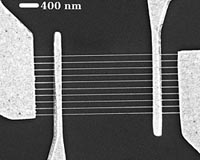 |
Cambridge, UK (SPX) Aug 03, 2009 A team of physicists from the Universities of Cambridge and Birmingham have shown that electrons in narrow wires can divide into two new particles called spinons and a holons. The electron is a fundamental building block of nature and is indivisible in isolation, yet a new experiment has shown that electrons, if crowded into narrow wires, are seen to split apart. The electron is responsible for carrying electricity in wires and for making magnets. These two properties of magnetism and electric charge are carried by electrons which seem to have no size or shape and are impossible to break apart. However, what is true about the properties of a single electron does not seem to be the case when electrons are brought together. Instead the like-charged electrons repel each other and need to modify the way they move to avoid getting too close to each other. In ordinary metals this does not usually make much difference to their behaviour. However, if the electrons are put in a very narrow wire the effects are exacerbated as they find it much harder to move past each other. In 1981, physicist Duncan Haldane conjectured theoretically that under these circumstances and at the lowest temperatures the electrons would always modify the way they behaved so that their magnetism and their charge would separate into two new types of particle called spinons and holons. The challenge was to confine electrons tightly in a 'quantum wire' and bring this wire close enough to an ordinary metal so that the electrons in that metal could 'jump' by quantum tunneling into the wire. By observing how the rate of jumping varies with an applied magnetic field the experiment reveals how the electron, on entering the quantum wire, has to fall apart into spinons and holons. The conditions to make this work comprised a comb of wires above a flat metal cloud of electrons. The Cambridge physicists, Yodchay Jompol and Chris Ford, clearly saw the distinct signatures of the two new particles as the Birmingham theorists, Tim Silk and Andy Schofield, had predicted. Dr Chris Ford from the University of Cambridge's Cavendish Laboratory says, 'We had to develop the technology to pass a current between a wire and a sheet only 30 atomic widths apart. 'The measurements have to be made at extremely low temperatures, about a tenth of a degree above absolute zero. 'Quantum wires are widely used to connect up quantum "dots", which may in the future form the basis of a new type of computer, called a quantum computer. Thus understanding their properties may be important for such quantum technologies, as well as helping to develop more complete theories of superconductivity and conduction in solids in general. This could lead to a new computer revolution.' Professor Andy Schofield from the University of Birmingham's School of Physics and Astronomy says, 'The experiment to test this is based on an idea I had together with three colleagues almost 10 years ago. At that time the technology required to implement the experiment was still a long way off. 'What is remarkable about this new experiment is not just the clarity of the observation of the spinon and holon, which confirms some earlier studies, but that the spinon and holon are seen well beyond the region that Duncan Haldane originally conjectured. 'Our ability to control the behaviour of a single electron is responsible for the semiconductor revolution which has led to cheaper computers, iPods and more. Whether we will be able to control these new particles as successfully as we have the single electron remains to be seen. What it does reveal is that bringing electrons together can lead to new properties and even new particles.' Share This Article With Planet Earth
Related Links University of Cambridge Powering The World in the 21st Century at Energy-Daily.com
 Graphene Has High Current Capacity, Thermal Conductivity
Graphene Has High Current Capacity, Thermal ConductivityAtlanta GA (SPX) Aug 03, 2009 Recent research into the properties of graphene nanoribbons provides two new reasons for using the material as interconnects in future computer chips. In widths as narrow as 16 nanometers, graphene has a current carrying capacity approximately a thousand times greater than copper - while providing improved thermal conductivity. The current-carrying and heat-transfer measurements were ... read more |
|
| The content herein, unless otherwise known to be public domain, are Copyright 1995-2009 - SpaceDaily. AFP and UPI Wire Stories are copyright Agence France-Presse and United Press International. ESA Portal Reports are copyright European Space Agency. All NASA sourced material is public domain. Additional copyrights may apply in whole or part to other bona fide parties. Advertising does not imply endorsement,agreement or approval of any opinions, statements or information provided by SpaceDaily on any Web page published or hosted by SpaceDaily. Privacy Statement |